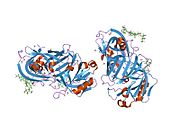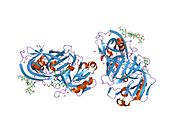Cathepsin D
Ensembl | |||||||||
|---|---|---|---|---|---|---|---|---|---|
| UniProt | |||||||||
| RefSeq (mRNA) | |||||||||
| RefSeq (protein) | |||||||||
| Location (UCSC) | Chr 11: 1.75 – 1.76 Mb | Chr 7: 141.93 – 141.94 Mb | |||||||
| PubMed search | [3] | [4] | |||||||
| View/Edit Human | View/Edit Mouse |
Cathepsin D is a
Alzheimer disease.[6] Homozygous deletion of the CTSD gene leads to early lethality in the postnatal phase.[9] Deficiency of CTSD gene has been reported an underlying cause of neuronal ceroid lipofuscinosis (NCL).[10]
Structure
Gene
The CTSD gene is located at chromosome 11.
Protein
The catalytic sites of cathepsin D include two critical aspartic residues (amino acid 33 and 231) located on the 14 kDa and 34kDa chains.[11] The ultimate form of mature cathepsin D is composed of 337 amino acid residues, 196 amino acid residues in the heavy chain and 141 in the light chain. These two chains are linked by the hydrophobic effect.[12]
Function
The optimum pH for cathepsin D in vitro is 4.5-5.0.VEGF-D, which might partly explain its relevance for tumor progression.[22]
Clinical significance
The NCLs present with progressive loss of visual function and neurodevelopmental decline,
hemorrhage and increase apoptosis in thymus, indicating that cathepsin D is required in certain epithelial cells for tissue remodeling and renewal.[9] It is also reported that there might be a strong effect for CTSD genotype on Alzheimer disease risk in male.[25] Cathepsin D enzymatic activity induces hydrolytic modification of apolipoprotein B-100-containing lipoproteins, including LDL, which means it may be involved in atherosclerosis as well.[18][26]
Interaction
References
- ^ a b c GRCh38: Ensembl release 89: ENSG00000117984 – Ensembl, May 2017
- ^ a b c GRCm38: Ensembl release 89: ENSMUSG00000007891 – Ensembl, May 2017
- ^ "Human PubMed Reference:". National Center for Biotechnology Information, U.S. National Library of Medicine.
- ^ "Mouse PubMed Reference:". National Center for Biotechnology Information, U.S. National Library of Medicine.
- PMID 3927292.
- ^ a b "Entrez Gene: CTSD cathepsin D".
- PMID 5419752.
- PMID 2760027.
- ^ PMID 7641679.
- ^ PMID 16738059.
- PMID 8467789.
- PMID 18296260.
- PMID 3378211.
- PMID 11779865.
- S2CID 5685201.
- ISBN 978-1-4051-1922-1.
- PMID 16354654.
- ^ PMID 12750117.
- PMID 9337526.
- ^ PMID 18396408.
- PMID 15456852.
- PMID 31099754.
- PMID 16046508.
- PMID 12651610.
- PMID 11304834.
- PMID 17032648.
- PMID 4912600.
- S2CID 17149825.
- PMID 21709160.
- S2CID 34224448.
- PMID 10508159.
Further reading
- Chao J, Miao RQ, Chen V, Chen LM, Chao L (January 2001). "Novel roles of kallistatin, a specific tissue kallikrein inhibitor, in vascular remodeling". Biological Chemistry. 382 (1): 15–21. S2CID 33204682.
- Leto G, Tumminello FM, Crescimanno M, Flandina C, Gebbia N (2004). "Cathepsin D expression levels in nongynecological solid tumors: clinical and therapeutic implications". Clinical & Experimental Metastasis. 21 (2): 91–106. S2CID 3476324.
- Liaudet-Coopman E, Beaujouin M, Derocq D, Garcia M, Glondu-Lassis M, Laurent-Matha V, Prébois C, Rochefort H, Vignon F (June 2006). "Cathepsin D: newly discovered functions of a long-standing aspartic protease in cancer and apoptosis". Cancer Letters. 237 (2): 167–79. S2CID 41309909.
- Knight CG, Barrett AJ (April 1976). "Interaction of human cathepsin D with the inhibitor pepstatin". The Biochemical Journal. 155 (1): 117–25. PMID 938470.
- Gulnik S, Baldwin ET, Tarasova N, Erickson J (September 1992). "Human liver cathepsin D. Purification, crystallization and preliminary X-ray diffraction analysis of a lysosomal enzyme". Journal of Molecular Biology. 227 (1): 265–70. PMID 1522590.
- Conner GE, Richo G (February 1992). "Isolation and characterization of a stable activation intermediate of the lysosomal aspartyl protease cathepsin D". Biochemistry. 31 (4): 1142–7. S2CID 3014149.
- Fujita H, Tanaka Y, Noguchi Y, Kono A, Himeno M, Kato K (August 1991). "Isolation and sequencing of a cDNA clone encoding rat liver lysosomal cathepsin D and the structure of three forms of mature enzymes". Biochemical and Biophysical Research Communications. 179 (1): 190–6. PMID 1883350.
- Dunn AD, Crutchfield HE, Dunn JT (October 1991). "Thyroglobulin processing by thyroidal proteases. Major sites of cleavage by cathepsins B, D, and L". The Journal of Biological Chemistry. 266 (30): 20198–204. PMID 1939080.
- Lenarcic B, Krasovec M, Ritonja A, Olafsson I, Turk V (March 1991). "Inactivation of human cystatin C and kininogen by human cathepsin D". FEBS Letters. 280 (2): 211–5. S2CID 23798502.
- Redecker B, Heckendorf B, Grosch HW, Mersmann G, Hasilik A (1991). "Molecular organization of the human cathepsin D gene". DNA and Cell Biology. 10 (6): 423–31. PMID 2069717.
- Conner GE, Udey JA (1990). "Expression and refolding of recombinant human fibroblast procathepsin D". DNA and Cell Biology. 9 (1): 1–9. PMID 2180427.
- Capony F, Rougeot C, Montcourrier P, Cavailles V, Salazar G, Rochefort H (July 1989). "Increased secretion, altered processing, and glycosylation of pro-cathepsin D in human mammary cancer cells". Cancer Research. 49 (14): 3904–9. PMID 2736531.
- Lenarcic B, Kos J, Dolenc I, Lucovnik P, Krizaj I, Turk V (July 1988). "Cathepsin D inactivates cysteine proteinase inhibitors, cystatins". Biochemical and Biophysical Research Communications. 154 (2): 765–72. PMID 3261170.
- Westley BR, May FE (May 1987). "Oestrogen regulates cathepsin D mRNA levels in oestrogen responsive human breast cancer cells". Nucleic Acids Research. 15 (9): 3773–86. PMID 3588310.
- Terayama H, Fukuzumi R (1987). "Ubiquitous presence of calciferin-like and cathepsin D-like activities in the sera (vertebrates) and humoral fluids (invertebrates)". Comparative Biochemistry and Physiology. B, Comparative Biochemistry. 87 (4): 675–9. PMID 3665421.
- Sekiguchi K, Siri A, Zardi L, PMID 3988746.
- Lemansky P, Gieselmann V, Hasilik A, von Figura K (August 1984). "Cathepsin D and beta-hexosaminidase synthesized in the presence of 1-deoxynojirimycin accumulate in the endoplasmic reticulum". The Journal of Biological Chemistry. 259 (16): 10129–35. PMID 6236213.
- Dreyer RN, Bausch KM, Fracasso P, Hammond LJ, Wunderlich D, Wirak DO, Davis G, Brini CM, Buckholz TM, König G (September 1994). "Processing of the pre-beta-amyloid protein by cathepsin D is enhanced by a familial Alzheimer's disease mutation". European Journal of Biochemistry. 224 (2): 265–71. PMID 7523115.
- Atkins KB, Troen BR (July 1995). "Regulation of cathepsin D gene expression in HL-60 cells by retinoic acid and calcitriol". Cell Growth & Differentiation. 6 (7): 871–7. PMID 7547509.
External links
- The MEROPS online database for peptidases and their inhibitors: A01.009 Archived 2008-04-02 at the Wayback Machine
- GeneReviews/NIH/NCBI/UW entry on Neuronal Ceroid-Lipofuscinoses
- PDBe-KB provides an overview of all the structure information available in the PDB for Human Cathepsin D



